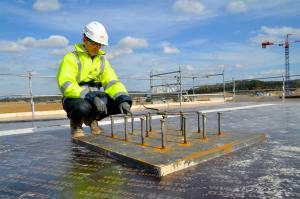Take in the view and enjoy it while you can. In a couple months, the spectacular pattern formed by the 493 columns in the Tokamak Complex Seismic Pit—the emblematic image of ITER construction—will have vanished from view.
The lone scaffolding that was erected two weeks ago at the centre of the pit has already been joined by dozens of others. "Everything will be covered," says ITER Nuclear Buildings Section Leader Laurent Patisson. Once the structures are in place, a steel rebar skeleton will be installed on top of them and pouring of the 1.5-metre-thick B2 slab will begin plot by plot (or "pour by pour") —a process which should take about nine months.
"The propping and formwork structures will support the weight of the rebar and concrete until the hardening of the concrete makes it possible to transfer the effort onto the seismic pads," adds Laurent. "A total of 15,000 m³ of concrete will be poured, which—added to the weight of the rebar (~ 4,000 tonnes)—will amount to a load of some 37,500 tonnes."
Creating a reinforced slab over formwork structures that are supported by braced scaffoldings is a common technique. The very same process was implemented, two years ago, on the nuclear research reactor Jules-Horowitz (RJH) that is being constructed at CEA-Cadarache.
Every installation has its own geometry, however, which is reflected in the complex pattern of the steel reinforcement bars. "We have to demonstrate constructability prior to pouring the actual slab," explains Laurent. "We also have to qualify the concrete and test the efficiency of the vibration techniques."
To that effect, a 150 m² mockup has been created on the platform to the west of the Seismic Pit. "Although 3D models of the rebar arrangements have been produced, we need a hands-on experience of the difficulties we may encounter." Four different areas of rebar, presenting specific challenges (density, complexity), will be reproduced at 1:1 scale in the mockup. Work on the mockup began last week.
The mockup will also allow the practice installation and testing of the anchor plates that will be embedded into the concrete. These thick steel plates of various sizes, all dotted with long spikes (see picture), will reach deep into the concrete.



